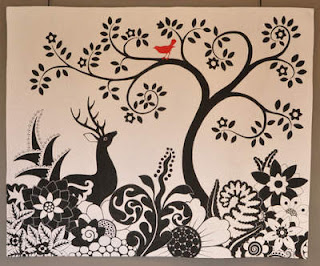I'm so pleased to introduce you to Mrs. Nina Lise Moen.
Welcome to Subversive Stitchers! -- Dawn
 My name is Nina Lise Moen. I’m 47 years old, and live in Stavanger, Norway where I share my life with my husband, our grown up daughter and our 2½ year old grandson.
My name is Nina Lise Moen. I’m 47 years old, and live in Stavanger, Norway where I share my life with my husband, our grown up daughter and our 2½ year old grandson. I come from a long line of creative and highly skilled needle workers and seamstresses as both my mother and grandmothers have been avid crafters. I have been knitting, crocheting and embroidering for as long as I can remember, and have made my own designs and knitting patterns since I was a teenager. Now I am a textile artist, designing Mrs, Moen quilting patterns and teaching workshops.
With a background previously in finance and the corporate world, this 11 year long journey into the textile arts has taken my life into a quite different direction.
We have a long crafting tradition in Norway like embroidery of bunads (our national dress, of which I have made a Rogalandsbunad), Rosemaling, Hardanger embroidery, Lusekofte knitting, and traditional akel weaving.
When it comes to patchwork and quilting, we are highly influenced by the American quilting industry, and to some extent the German and Japanese. Even though our patchwork history has been well documented, it was not something everybody’s grandmother did.
We don’t have Norwegian quilting fabric, but there are interior fabrics with Norwegian design, some of them suitable for quilting. Even though we mainly use American fabrics, the choice of colours and colour combinations are often different. We have quite a few Norwegian quilting books authors and pattern designers, some of them with their own distinct style, others more influenced by American design. As we use duvets for bedding, we use our larger quilts for bedspreads. Smaller projects like table runners, pillows and bag are highly popular.
Guilds are a large part of quilting life all over the world and also in Norway, with traditional quilt guilds and Husflidslag. I am so lucky to be part of two; the regional guild, in which I serve my 4th year on the board, and 1st year as the leader, and a small informal group.
My work
I love turning scraps of fabric into fun, small quilts, of which “But I have nothing to wear” and “Dance in the rain” are two favourites (pictured here.)
These are rather personal stories. One of them is “Hot and Cold; 7 and 1/2 years," which I entered into the Blogger’s Quilt Festival this fall. It was made for the European Quilt Association’s Suitcase exhibition. (See first photo above) “Hot and Cold..." tells the story of being a mom during a daughter’s illness.
It was quite a challenge getting each figure just the right size and in the right position, so that they seem to walk and drag the most fragile ones over the surface and into the future. You can read more about the quilt here.
“Class picture” is another favourite of mine. It started out as a hand appliqué project, and grew from there.
Artist’s statement: “A class is very much like a quilt; bits and pieces making up a whole. When you look closer, you’ll see the differences in backgrounds, styles and personalities; and who’s not fitting in.
You’ll find me in the back, by the window with the other oddballs; bright and shining.”
The quilt was a part of the exhibition at Festival of Quilts in Birmingham, England in 2007. You can read more about the quilt here.
Currently -- I’m taking my first art class learning to paint with acrylics. It is so much fun with just the right amount of theory and lots of playing with colours and textures.-- I'm working on finishing UFOs and find a lot of inspiration in old projects and taking them into another direction.
-- I’m working on woollen projects like this bag (photo and detail photo) made from a knitted and matted self made material with appliquéd and embroidered circles.
-- I’m finishing my Christmas patterns and preparing for a workshop I will teach in November.
If you would like to know more about me and my work, visit me at MrsMoen

























